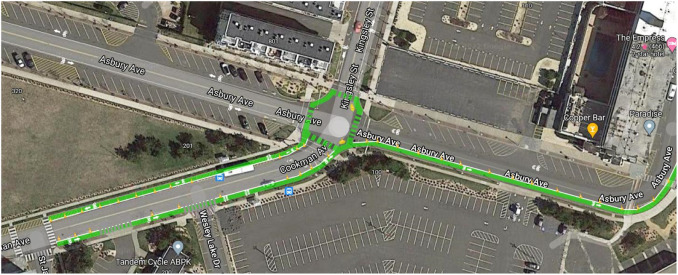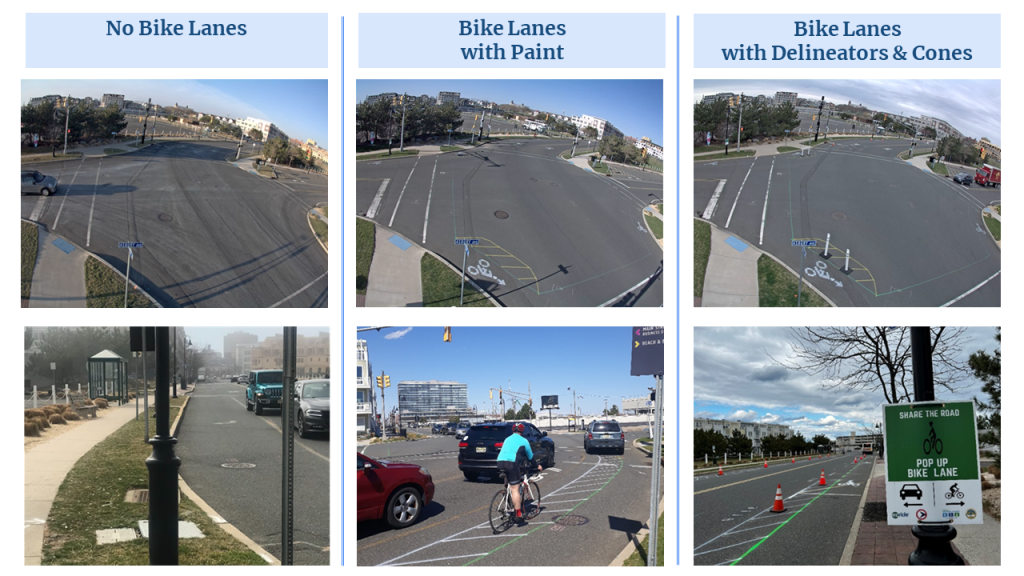A new Rutgers University study sponsored by the U.S. National Science Foundation in collaboration with the FHWA shows that protected bicycle lanes were associated with a 20 to 30 percent reduction in traffic speeds. Interested in the topic? Rutgers hosted a free Micromobility Workshop on Friday, March 22, 2024 at the Bloustein School, in New Brunswick, NJ.
The Traffic Calming Effects of Delineated Bicycle Lanes
In an experiment undertaken in Asbury Park, NJ, nine researchers at Rutgers University, including at the Edward J. Bloustein School of Planning and Public Policy, found an association between protected bicycle lanes and a 20 to 30 percent reduction in average maximum traffic speeds. The average top speeds of vehicles dropped by 28 percent overall. For vehicles turning right, recorded average speeds decreased by 21 percent in the presence of protected bicycle facilities, and vehicles traveling straight through the study intersection had average speeds reduced by up to 8 percent.

A Bloustein School studio plan to implement a temporary bike lane in Asbury Park, NJ.
This experiment incorporated 24-hour video footage of the intersection of Asbury Avenue, Cookman Avenue, and Kingsley Street in downtown Asbury Park. Footage was recorded over ten dates in March and April 2022, before and after a temporary bicycle lane was installed as part of a Bloustein School studio project. The protected bike lane was delineated with temporary chalk paint at the intersection and along Cookman and Asbury avenues. Physical protection was also provided by temporary materials, including traffic cones and plastic delineators. The project was highlighted in the video “Demonstrating the Need: Installing Temporary Roadway Projects.”

The experiment measured traffic speeds at the intersection in three states: no bike lanes, bike lanes with paint only, bike lanes with paint, plastic delineators, and cones.
On different dates, the traffic camera video footage was used to measure the speeds of vehicles traveling through the intersection. During ten days of recording, the presence of traffic cones and plastic delineators showed the largest reduction in vehicle speeds. When the physical protection was removed, the presence of the paint alone was also associated with a reduction of speeds for right-turning vehicles of 11 to 15 percent. Vehicle speeds with the protected and paint-only conditions were compared to those recorded before the temporary bike lane was installed.
The results reinforce why the Federal Highway Administration has identified bike lanes as one of its Proven Safety Countermeasures. Most reported crashes in the United States occur at intersections, and reductions in vehicle speeds can make intersections safer for all road users, including people walking, rolling, and driving. The report authors note, “this finding is significant in that it suggests that delineated bike lanes can reduce traffic speeds, making the overall road environment safer for all. The pop-up bike lane reduced the traffic lane width and created a sharper turning radius, which likely served as a traffic calming mechanism.”
The study is published in the Journal of Urban Mobility and can be found here.
Micromobility 2.0 Workshop: Smarter Strategies for Safe Travel
The Micromobility 2.0 Workshop, funded through a grant provided by the National Science Foundation, was held on Friday, March 22, 2024. The workshop bridged research and practice surrounding the use of micromobility devices (e-bikes, e-scooters, bicycles, etc.) and how best to address safety, infrastructure, and the use of innovative technology.
The workshop was hosted at the James Florio Special Events Forum at the Edward J. Bloustein School of Planning and Public Policy at Rutgers University, 33 Livingston Avenue, New Brunswick, NJ.
More information on the workshop can be found here.
The Micromobility Project – Edward J. Bloustein School of Planning and Public Policy
The Micromobility Project out of the Edward J. Bloustein School of Planning and Public Policy is sponsored by the U.S. National Science Foundation in collaboration with the Federal Highway Administration for a four-year period starting from October 1, 2020. The project’s research focuses on “near misses” between vehicles and pedestrians, e-scooters, e-bikes, and bicycles. The project’s objective is to make micromobility smarter and safer.
The major goal of this project is to use new methods to gather and process data to identify what determines pedestrian and micromobility risk. It seeks to create tools that deliver integrated solutions to micromobility safety challenges. In collaboration with industry partners Veo, researchers test the safety tools to serve the needs of real communities like Asbury Park. The research team continues to work for Jersey City and Highland Park, NJ.
For more information on Micromobility in New Jersey, check out the NJ Bicycle and Pedestrian Resource Center’s Micromobility page.
